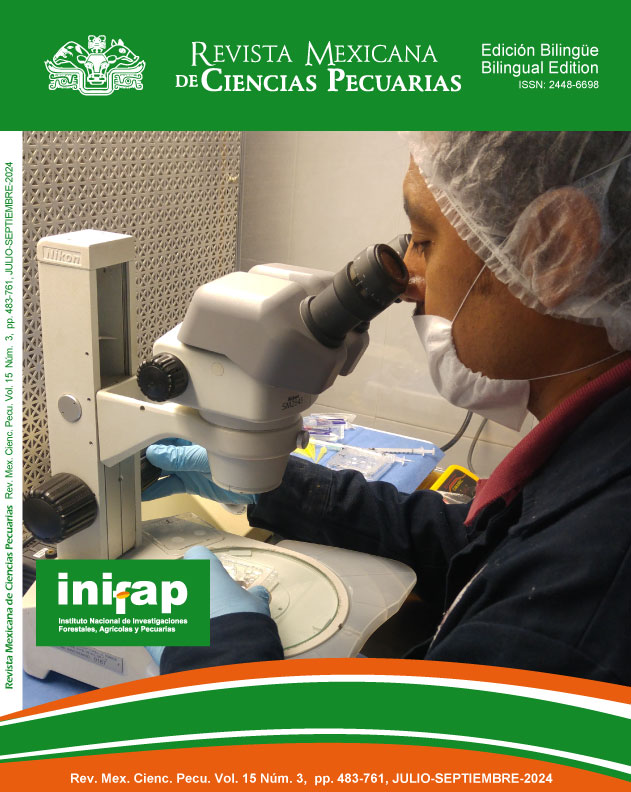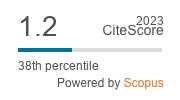Uso y evolución del sexado espermático en bovinos. Revisión
DOI:
https://doi.org/10.22319/rmcp.v15i3.6372Palabras clave:
DNA, Sexado espermático, Cromosomas sexuales, Citometría de flujoResumen
Desde el inicio comercial del sexado espermático en la inseminación artificial, la adopción de esta tecnología por la industria ganadera (productores, médicos veterinarios y compañías de genética) ha sido una realidad en la producción bovina, principalmente en ganado lechero. La presente revisión, es una descripción de los inicios del sexado espermático, su desarrollo, aplicación a nivel comercial, y evolución hasta la actualidad. Los eventos más significativos fueron sin lugar a dudas la determinación de la diferencia en el contenido de DNA entre los espermatozoides portadores del cromosoma “Y” o “X”, el flujo de estos en el citómetro, y su separación en los así llamados espermatozoides “Y” y “X”. Los siguientes logros que favorecieron la aplicación de esta tecnología de forma comercial fueron la determinación de la concentración óptima y la criopreservación exitosa del semen sexado; desde entonces, las investigaciones para tratar de disminuir los efectos deletéreos del proceso de sexado no se detuvieron, llegando hasta el surgimiento de nuevas tecnologías de sexado espermático donde este efecto es mínimo. La técnica más ampliamente difundida de forma comercial es el ultrasexado de 4 millones de espermatozoides (SexedULTRA-4M™), en la cual se modificaron completamente el método, los medios y los citómetros, con lo que esta tecnología tiene resultados muy similares a los obtenidos con semen no sexado (semen convencional). Existe otra tecnología de sexado espermático llamada Sexcell™ que se oferta de forma comercial, en la cual han obtenido resultados similares a los obtenidos con semen convencional, pero solo en vaquillas. Con estos avances, el sexado espermático se muestra como una tecnología en constante desarrollo y de alto impacto en la ganadería bovina.
Descargas
Citas
Seidel Jr GE, Garner DL. Current status of sexing mammalian spermatozoa. Reproduction 2002;124:733-743.
Garner DL. Sex-sorting mammalian sperm: Concept to application in animals. J Androl 2001;22(4):519-26.
Garner DL, Seidel Jr GE. Past, present and future perspectives on sexing sperm. Canadian J Anim Sci 2003;83:375-384.
Seidel Jr GE. Sperm sexing technology. The transition to commercial application. An introduction to the symposium “Update on sexing mammalian sperm”. Theriogenology 2009;71:1-3.
Garner DL, Seidel Jr GE. History of commercializing sexed semen for cattle. Theriogenology 2008;69:886-895.
Oses MV, Teruel MT, Cabodevila JA. Utilización de semen bovino sexado en inseminación artificial, transferencia embrionaria y fertilización in vitro. RedVet 2009;20:138-145.
Espinosa CR, Córdova AI. Sexing sperm of domestic animals. Trop Anim Health Prod 2012;45(1):1-8.
González-Marin C, Lenz RW, Gilligan TB, Evans KM, Gongora CE, Moreno JF, et al. SexedULTRA™, a new method of processing sex sorted bovine sperm improves post-thaw sperm quality and in vitro fertility. Reprod Fertil Dev 2017;29(1):204.
Perry GA, Walker JA, Rich JJJ, Northrop EJ, Perkins SD, Beck EE, et al. Influence of Sexcel™ (gender ablation technology) gender-ablated semen in fixed-time artificial insemination of beef cows and heifers. Theriogenology 2020;146:140-144.
Yadav HP, Sahu SK, Lone SA, Shah N, Singh A, Verma UK, et al. Advances in sperm sexing. J Exp Zool India 2018;21(1):1-9.
Domínguez E, Moreno-Irusta A, Castex HR, Bragulat AF, Ugaz C, Clemente H, et al. Sperm sexing mediated by magnetic nanoparticles in donkeys, a preliminary in vitro study. J Equ Vet Sci 2018;65:123-127.
Gledhill BL, Lake S, Steinmetz LL, Gray JW, Crawford JR, Dean PN, et al. Flow microfluorometric analysis of sperm DNA content: effect of cell shape on the fluorescence distribution. J Cell Physiol 1976;87(3):367-375.
Garner DL. Flow cytometric sexing of mammalian sperm. Theriogenology 2006;65(5):943-957.
Garner DL, Gledhill BL, Pinkel D, Lake S, Stephenson D, Van Dilla MA, et al. Quantification of the X- and Y-chromosome-bearing spermatozoa of domestic animals by flow cytometry. Biol Reprod 1983;28(2):312-321.
Johnson LA, Pinkel D. Modification of a laser-based flow cytometer for high-resolution DNA analysis of mammalian spermatozoa. Cytometry 1986;7(3):268-273.
Johnson LA, Flook JP, Look MV, Pinkel D. Flow sorting of X and Y chromosome-bearing spermatozoa into two populations. Gamete Res 1987;16(1):1-9.
Johnson LA, Flook JP, Hawk HW. Sex preselection in rabbits: live births from X and Y sperm separated by DNA and cell sorting. Biol Reprod 1989;41(2):199-203.
Cran DG, Johnson LA, Miller NG, Cochrane D, Polge C. Production of bovine calves following separation of X- and Y-chromosome bearing sperm and in vitro fertilization. Vet Rec 1993;132(2):40-41.
Seidel Jr GE, Johnson LA, Allen CA, Welch GR, Holland MD, Brink Z, et al. Artificial insemination with X- and Y-bearing bovine sperm. Theriogenology 1996;45:309.
Seidel Jr GE, Allen CH, Johnson LA, Holland MD, Brink Z, Welch GR. Uterine horn insemination of heifers with very low numbers of nonfrozen and sexed sperm. Theriogenology 1997;48:1255–1264.
Schenk JL, Suh TK, Cran DG, Seidel GE Jr. Cryopreservation of flow-sorted bovine spermatozoa. Theriogenology 1999;52(8):1375-1391.
https://www.stgen.com Consultada 15 Sep, 2020.
Bodmer MF, Janett M, Hässing N, den Dass P, Reichert R, Thun R. Fertility in heifers and cows after low dose insemination with sex-sorted and non-sorted sperm under field conditions. Theriogenology 2005;64:1647-1655.
Frijters ACJ, Mullaart E, Roelofs RMG, van Hoorne RP, Moreno JF, Moreno O, et al. What affects fertility of sexed bull semen more, low sperm dosage or the sorting process? Theriogenology 2009;71:64-67.
Gosálvez J, Ramirez MA, López-Fernández C, Crespo F, Evans KM, Kjelland ME, et al. Sex-sorted bovine spermatozoa and DNA damage: I. Static features. Theriogenology 2011;75:197-205.
DeJarnette MJ, McCleary CR, Leach MA, Moreno JF, Nebel RL, Marshall CE. Effects of 2.1 and 3.5 × 106 sex sorted sperm dosages on conception rates of Holstein cows and heifers. J Dairy Sci 2010;93:4079-4085.
Seidel Jr GE, Schenk JL. Pregnancy rates in cattle with cryopreserved sexed sperm: Effects of sperm numbers per insemínate and site of sperm deposition. Anim Reprod Sci 2008;105:129-138.
Seidel Jr GE, Schenk JL, Herickhoff LA, Doyle SP, Brink Z, Green RD, et al. Insemination of heifers with sexed sperm Theriogenology 1999;52:1407-1420.
Morotti F, Sanches BV, Pontes JH, Basso AC, Siqueira ER, Lisboa LA, et al. Pregnancy rate and birth rate of calves from a large-scale IVF program using reverse-sorted semen in Bos indicus, Bos indicus-taurus, and Bos taurus cattle. Theriogenology 2014;81(5):696-701.
Underwood SL, Bathgate R, Ebsworth M, Maxwell WM, Evans G. Pregnancy loss in heifers after artificial insemination with frozen-thawed, sex-sorted, re-frozen-thawed dairy bull sperm. Anim Reprod Sci 2010;118(1):7-12.
Underwood SL, Bathgate R, Pereira DC, Castro A, Thomson PC, Maxwell WM, et al. Embryo production after in vitro fertilization with frozen-thawed, sex-sorted, re-frozen-thawed bull sperm. Theriogenology 2010;73(1):97-102.
Underwood SL, Bathgate R, Maxwell WM, Evans G. Birth of offspring after artificial insemination of heifers with frozen-thawed, sex-sorted, re-frozen-thawed bull sperm. Anim Reprod Sci 2010;118(2-4):171-175.
Mikkola M, Taponen J. Quality and developmental rate of embryos produced with sex-sorted and conventional semen from superovulated dairy cattle. Theriogenology 2017;87:135-140.
Larson JE, Lamb GC, Funnell BJ, Bird S, Martins A, Rodgers JC. Embryo production in superovulated Angus cows inseminated four times with sexed-sorted or conventional, frozen-thawed semen. Theriogenology 2010;73(5):698-703.
Hayakawa H, Hirai T, Takimoto A, Ideta A, Aoyagi Y. Superovulation and embryo transfer in Holstein cattle using sexed sperm. Theriogenology 2009;71(1):68-73.
Wheeler MB, Rutledge JJ, Fischer-Brown A, VanEtten T, Malusky S, Beebe DJ. Application of sexed semen technology to in vitro embryo production in cattle. Theriogenology 2006;65:219-227.
Lu KH, Cran DG, Seidel Jr GE. In vitro fertilization with flow-cytometrically sorted bovine sperm. Theriogenology 1999;52(8):1393-1405.
Wilson RD, Weigel KA, Fricke PM, Rutledge JJ, Leibfried-Rutledge ML, Matthews DL. In vitro production of Holstein embryos using sex-sorted sperm and oocytes from selected cull cows. J Dairy Sci 2005;88:776-782.
Malcom V, Marfil M, Calvi M, Rigali F, Pugliese M, Gutierrez j. Comparison of in vitro fertilizing capacity of frozen-thawed sex-sorted and sex-sorted frozen-thawed bull spermatozoa. Reprod Fertil Dev 2006;19:298.
Siqueira LGB, Dikmen S, Ortega MS, Hansen PJ. Postnatal phenotype of dairy cows is altered by in vitro embryo production using reverse X-sorted semen. J Dairy Sci 2017;100(7):5899-5908.
Johnson LA, Welch GR. Sex preselection: high speed flow cytometric sorting of X and Y sperm for maximum efficiency. Theriogenology 1999;52:1323-1341.
Vishwanath R, Moreno JF. Review: Semen sexing – current state of the art with emphasis on bovine species. Animal 2018;12(Suppl 1):1-12.
Gonzalez-Marin C, Gongora CE, Guilligan TB, Evans KM, Moreno JF, Vishwanath R. In vitro sperm quality and DNA integrity of SexedULTRATM sex sorted sperm compared to non sorted bovine sperm. Theriogenology 2018;114:40-45.
Vishwanath R. SexedULTRA – raising the fertility bar of sexed sorted semen. In Proc 25th technical conference on artificial insemination and reproduction. National Association of Artificial Breeders, September 2014, Wisconsin, USA, 57-61.
Lenz RW, Gonzalez-Marin C, Gilligan TB, DeJarnette JM, Utt MD, Helser LA, et al. SexedULTRA™, a new method of processing sex sorted bovine sperm improves conception rates. Reprod Fertil Dev 2017;29(1):203-204.
Dell’Eva G, Bolognini D, Lacono E, Merlo B. Superovulation protocols for dairy cows bred with SexedULTRATM sex sorted semen. Reprod Domest Anim 2019;54:756-761.
Crites BR, Vishwanath R, Arnett AM, Bridges PJ, Burris WR, McLeod KR, et al. Conception risk of beef cattle after fixed-time artificial insemination using either SexedUltra™ 4M sex-sorted semen or conventional semen. Theriogenology 2018;118:126-129.
Thomas JM, Locke JWC, Bonacker RC, Knickmeyer ER, Wilson DJ, Vishwanath R, et al. Evaluation of SexedULTRA 4MTM sex sorted semen in timed artificial insemination programs for mature beef cows. Theriogenology 2019;123:100-107.
Maicas C, Holden SA, Drake E, Cromie AR, Lonergan P, Butler ST. Fertility of frozen sex sorted sperm at 4x106 sperm per dose in lactating dairy cows in seasonal-calving pasture based herds. J Dairy Sci 2020;103:(1):929-939.
Álvarez H, Kjelland M, Villaseñor F, Pérez M, Romo S. Comparison of sexed semen ULTRA-4M with conventional semen for the in vitro production of bovine embryos. Reprod Fertil Dev 2020;32(1):161-162.
Velázquez A, Álvarez H, Kjelland M, Villaseñor F, Ariza G, Romo S. In vitro embryo production using prepubertal calf oocytes with conventional semen and sexed semen ULTRA-4M. Reprod Fertil Dev 2020;32(1)162.
Álvarez-Gallardo H, Kjelland ME, Pérez-Martínez M, Villaseñor-González F, Romo-García S. Evaluation of novel SexedULTRA-4M technology for in vitro bovine embryo production. Anim Reprod 2022;19(1)e20220018.
https://www.genusintelligen.com Consultada 15 Sep, 2020.
https://www.absglobal.com/mx/services/sexcel/ Consultada 15 Sep, 2020.
Descargas
Publicado
Cómo citar
-
Resumen659
-
PDF319
-
PDF 28
-
Texto completo27
-
Full text 9
Número
Sección
Licencia

Esta obra está bajo una licencia internacional Creative Commons Atribución-NoComercial-CompartirIgual 4.0.
Los autores/as que publiquen en la Revista Mexicana de Ciencias Pecuarias aceptan las siguientes condiciones:
De acuerdo con la legislación de derechos de autor, la Revista Mexicana de Ciencias Pecuarias reconoce y respeta el derecho moral de los autores/as, así como la titularidad del derecho patrimonial, el cual será cedido a la revista para su difusión en acceso abierto.

Esta obra está bajo una Licencia Creative Commons Atribución-NoComercial-CompartirIgual 4.0 Internacional.





